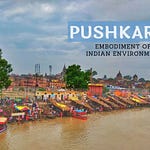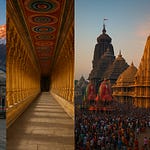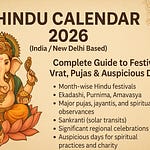There are places in the world that exist on maps, and then there are places like Devprayag, which exist beyond time, nestled in the folds of faith, nature, mythology, and cosmic purpose. Situated in the Garhwal Himalayas of Uttarakhand, Devprayag is not just a town—it’s a divine intersection of nature and the soul. It is here that the Bhagirathi and Alaknanda rivers unite, giving birth to the Ganga, the spiritual lifeline of India.
But Devprayag is more than just a confluence. It is where the divine becomes visible, where every ripple holds ancient wisdom, and every stone breathes the silence of sages.
🔱 The Name: More Than Just a Title
In Sanskrit, Devprayag translates to "The Holy Union of Gods." "Dev" means divine or god, and "Prayag" means confluence. This sacred merge is believed to be ordained by the gods themselves, and it’s one of the revered Panch Prayags (five confluences) in the spiritual geography of Uttarakhand.
Unlike the bustling city of Prayagraj, where Ganga merges with Yamuna and Saraswati, Devprayag is raw, wild, and intimate—the Ganga’s origin story written in stone and water.
🕉️ The Untold History: From Rishis to Ramayana
Devprayag’s legacy is ancient—older than recorded memory. Mythology speaks of King Bhagirath, who performed intense penance here to bring the celestial Ganga down to Earth to purify the ashes of his ancestors. That descent, cushioned by Lord Shiva's matted locks, culminated at this very spot—where two rivers of the heavens chose to become one.
But Devprayag also holds a Ramayana connection. It is believed that Lord Rama, after defeating Ravana, performed penance here to cleanse himself of Brahmahatya dosha—the karmic burden of killing a Brahmin, as Ravana was one.
🧘♂️ The Energy & Mystery
There is something indescribably magnetic about Devprayag. Even before reaching the actual confluence, you feel a shift in frequency. Locals say that this land is protected by ancient rishis, and that the energy vortex at the sangam is self-cleansing and self-charging.
One legend whispers that a third river, Saraswati, flows invisibly beneath the Earth and joins the sangam, making it a Triveni Sangam like in Prayagraj. No instruments have proved it—but in Devprayag, belief often precedes science.
🛕 Temples & Sacred Structures
1. Raghunathji Temple
Built in classic South Indian architecture, this 10th-century temple stands as a testimony to time. Dedicated to Lord Rama (Raghunathji), it is said to be where he meditated post-war. The temple houses a black stone idol of Rama, and its priesthood is passed down through generations.
2. Baitalshila Rock
A floating stone near the confluence, said to have divine energy. Locals believe touching it grants purification and emotional release.
3. Kyunkaleshwar Mahadev
An ancient shrine to Lord Shiva, often visited for inner healing and removal of planetary obstacles. The path to the temple is scenic and meditative.
🔔 Rituals and Daily Pujas
The spiritual rhythm of Devprayag is set by the confluence, which becomes a living altar at sunrise and sunset. Here's what pilgrims often experience:
Snan (Ritual Bath): A dip at the confluence is said to release karmic baggage, past life regrets, and inner unrest.
Tarpan and Shraddha: People perform last rites and offerings for their ancestors.
Ganga Aarti: Every evening, priests and devotees light lamps, chant mantras, and let diyas float down the river, symbolizing surrender to the divine flow.
Astrological Remedies: Priests known as Pandas perform specific rituals for dosha nivaran (removal of planetary faults).
🎉 Festivals & Spiritual Celebrations
Ganga Dussehra (May-June): Celebrating Ganga's descent to Earth with mass dips, music, and temple ceremonies.
Ram Navami: Lord Rama’s birth celebrated at Raghunathji temple with processions and prasad.
Deepawali & Kartik Purnima: A thousand oil lamps light up the confluence, creating a surreal golden reflection.
Makar Sankranti: Holy dip, sun worship, and offering gratitude to natural elements.
🧭 Things to Do & Spiritual Exploration
Spend sunrise in silence at the confluence—observe the color shift in water, and feel your mind quieten.
Take a slow walk through the narrow lanes, lined with old homes, ashrams, and ancient graffiti-like carvings on stone.
Visit nearby Chandrabadni Temple, one of the Shakti Peeths, located atop a mountain offering panoramic views.
Meet local priests who hold Vanshavali (family lineages) of thousands of pilgrims dating back centuries—stored in age-old books.
🚶 Travel Guide & Tips
By Air: Nearest airport is Jolly Grant, Dehradun (approx. 90 km).
By Train: Rishikesh is the nearest station, well connected to major cities.
By Road: Scenic drive via NH-58, passing through hills, valleys, and riverbeds. Taxis and buses run frequently from Rishikesh.
Best Time to Visit:
October to March for spiritual ambiance and cool weather.
Avoid July-August (monsoon season) due to landslides.
Stay Options:
Basic Dharamshalas for devotees.
Mid-range lodges with views of the confluence.
For comfort, stay in Rishikesh and plan a day trip.
🧡 Why Devprayag Still Matters
In an age of speed and screens, Devprayag reminds you to pause and flow. It teaches surrender, just like the rivers surrender themselves to one another. It shows you that divinity doesn’t need gold-plated temples—it’s found where earth, water, wind, and fire meet in silent harmony.
Devprayag is not a destination.
It is a moment in your spiritual journey when you remember who you are—pure, flowing, and part of something ancient and vast.










